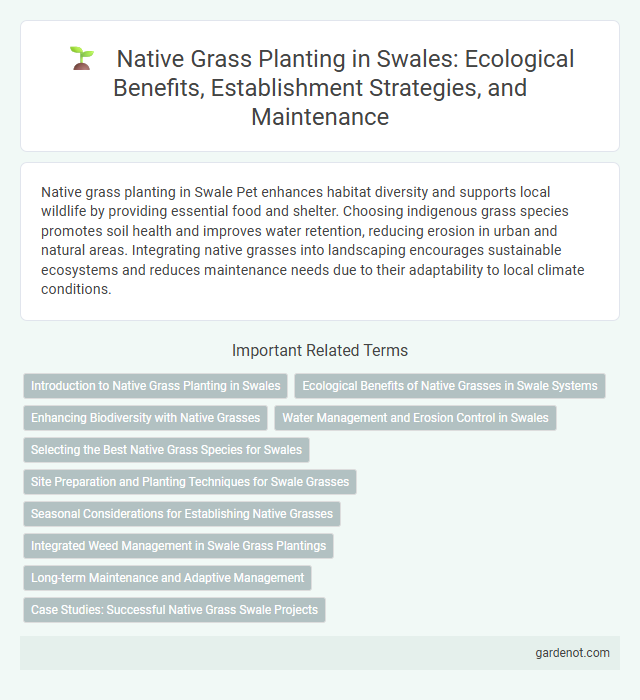Native grass planting in Swale Pet enhances habitat diversity and supports local wildlife by providing essential food and shelter. Choosing indigenous grass species promotes soil health and improves water retention, reducing erosion in urban and natural areas. Integrating native grasses into landscaping encourages sustainable ecosystems and reduces maintenance needs due to their adaptability to local climate conditions.
Introduction to Native Grass Planting in Swales
Native grass planting in swales enhances soil stabilization and improves water infiltration by mimicking natural ecosystems. Grasses such as little bluestem (Schizachyrium scoparium) and Indian grass (Sorghastrum nutans) thrive in swale conditions, promoting biodiversity and reducing erosion. Establishing native grasses in swales contributes to sustainable stormwater management and supports wildlife habitats.
Ecological Benefits of Native Grasses in Swale Systems
Native grasses in swale systems enhance soil stabilization by reducing erosion through deep root networks. Their drought tolerance improves water infiltration and retention, promoting groundwater recharge and reducing surface runoff. These grasses also support biodiversity by providing habitat and food sources for pollinators and other wildlife, contributing to a balanced ecosystem.
Enhancing Biodiversity with Native Grasses
Native grass planting in swales significantly enhances biodiversity by providing habitat and food sources for various pollinators, birds, and beneficial insects. These grasses improve soil health, support microbial communities, and stabilize soil structure, fostering a balanced ecosystem. Incorporating species such as big bluestem, switchgrass, and little bluestem promotes resilience against erosion and sustains local wildlife diversity.
Water Management and Erosion Control in Swales
Native grass planting in swales enhances water management by improving infiltration rates and reducing surface runoff through dense root systems. These deep-rooted grasses stabilize soil, effectively controlling erosion by binding soil particles and slowing water flow. Their adaptability to varying moisture conditions makes them ideal for sustaining swale functionality in diverse environments.
Selecting the Best Native Grass Species for Swales
Selecting the best native grass species for swales enhances erosion control and water filtration efficiency. Species such as big bluestem (Andropogon gerardii), switchgrass (Panicum virgatum), and little bluestem (Schizachyrium scoparium) thrive in swale environments due to their deep root systems and drought tolerance. These grasses also support local biodiversity by providing habitat for pollinators and native wildlife while maintaining soil stability.
Site Preparation and Planting Techniques for Swale Grasses
Effective site preparation for native grass planting in swales involves soil loosening and removal of competing vegetation to enhance root establishment and water infiltration. Employing planting techniques such as direct seeding or using plugs ensures optimal density and promotes rapid growth of native swale grasses like switchgrass, big bluestem, and little bluestem. Proper timing during early spring or fall aligns with natural rainfall patterns, maximizing seed germination and plant survival rates.
Seasonal Considerations for Establishing Native Grasses
Native grass planting in swales requires careful attention to seasonal timing, as optimal establishment occurs during early spring or late fall when soil moisture levels are naturally higher. Selecting native grass species adapted to local climate patterns ensures resilience to seasonal variations and promotes deep root development. Proper seasonal planning enhances water infiltration and erosion control, critical for swale performance and ecological benefits.
Integrated Weed Management in Swale Grass Plantings
Integrated Weed Management in swale native grass plantings combines mechanical, cultural, and chemical control methods to minimize invasive species while promoting native biodiversity. Selecting competitive native grass species and applying targeted herbicide treatments during early growth stages effectively suppresses weed establishment. Regular monitoring and adaptive management ensure sustainable swale vegetation, enhancing water infiltration and habitat function.
Long-term Maintenance and Adaptive Management
Native grass planting in swales enhances soil stability and supports local biodiversity, requiring long-term maintenance to ensure sustainable growth and resilience. Adaptive management practices include periodic monitoring for invasive species, adjusting mowing regimes, and supplementing plantings to address site-specific conditions and climate variability. These strategies optimize water filtration and habitat function while promoting ecosystem health over time.
Case Studies: Successful Native Grass Swale Projects
Case studies of native grass swale projects reveal significant improvements in stormwater management and soil erosion control, demonstrating the effectiveness of species such as Big Bluestem (Andropogon gerardii) and Switchgrass (Panicum virgatum). These projects in urban and agricultural settings highlight cost savings through reduced maintenance and enhanced groundwater recharge. Documented benefits include increased biodiversity, pollutant filtration, and resilience to extreme weather events, confirming native grasses as a sustainable solution for swale design.
Native grass planting Infographic

 gardenot.com
gardenot.com